Analysis of Financial Statement of AMP Ltd for 2017
VerifiedAdded on 2023/06/05
|14
|3638
|493
AI Summary
This assessment analyzes the financial statement of AMP ltd for the year 2017, debt equity position, key financial ratios, changes in capital structure, and risk management policies.
Contribute Materials
Your contribution can guide someone’s learning journey. Share your
documents today.
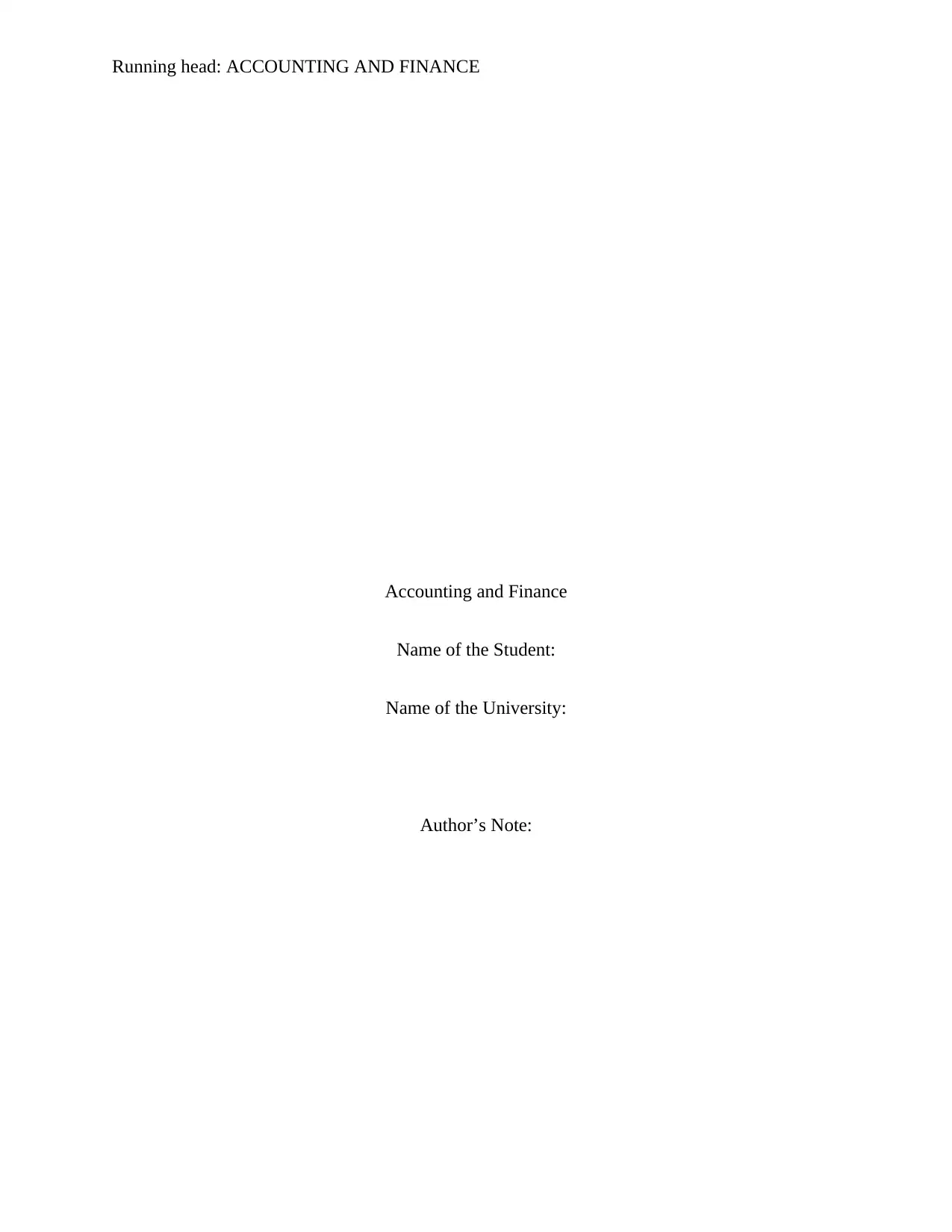
Running head: ACCOUNTING AND FINANCE
Accounting and Finance
Name of the Student:
Name of the University:
Author’s Note:
Accounting and Finance
Name of the Student:
Name of the University:
Author’s Note:
Secure Best Marks with AI Grader
Need help grading? Try our AI Grader for instant feedback on your assignments.

1
ACCOUNTING AND FINANCE
Executive Summary
The main purpose of this assessment is to conduct an analysis of the financial statement of AMP
ltd for the year 2017 in order to ensure that the business is meeting the performance standards.
The assessment also analyzes the debt equity position of the business and also makes comment
on the changes which have taken place in the same over the years. In order to analyze the
financial performance of the business, key financial ratios of the business are computed and
analyzed in a similar manner. Lastly, the assessment considers the material risks which are
disclosed in the annual report of the business for the year 2017 and how well the business has
managed such risks.
ACCOUNTING AND FINANCE
Executive Summary
The main purpose of this assessment is to conduct an analysis of the financial statement of AMP
ltd for the year 2017 in order to ensure that the business is meeting the performance standards.
The assessment also analyzes the debt equity position of the business and also makes comment
on the changes which have taken place in the same over the years. In order to analyze the
financial performance of the business, key financial ratios of the business are computed and
analyzed in a similar manner. Lastly, the assessment considers the material risks which are
disclosed in the annual report of the business for the year 2017 and how well the business has
managed such risks.
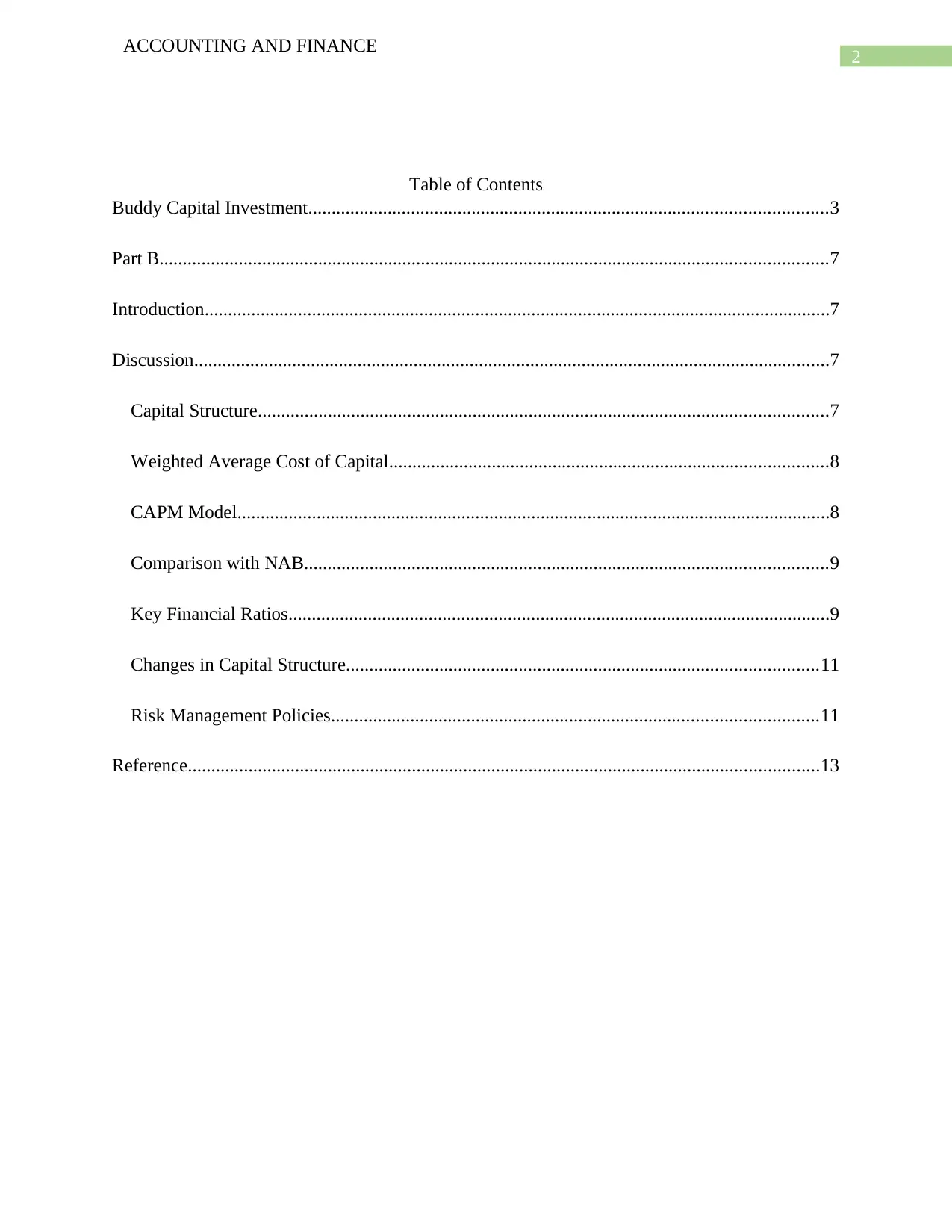
2
ACCOUNTING AND FINANCE
Table of Contents
Buddy Capital Investment...............................................................................................................3
Part B...............................................................................................................................................7
Introduction......................................................................................................................................7
Discussion........................................................................................................................................7
Capital Structure..........................................................................................................................7
Weighted Average Cost of Capital..............................................................................................8
CAPM Model...............................................................................................................................8
Comparison with NAB................................................................................................................9
Key Financial Ratios....................................................................................................................9
Changes in Capital Structure.....................................................................................................11
Risk Management Policies........................................................................................................11
Reference.......................................................................................................................................13
ACCOUNTING AND FINANCE
Table of Contents
Buddy Capital Investment...............................................................................................................3
Part B...............................................................................................................................................7
Introduction......................................................................................................................................7
Discussion........................................................................................................................................7
Capital Structure..........................................................................................................................7
Weighted Average Cost of Capital..............................................................................................8
CAPM Model...............................................................................................................................8
Comparison with NAB................................................................................................................9
Key Financial Ratios....................................................................................................................9
Changes in Capital Structure.....................................................................................................11
Risk Management Policies........................................................................................................11
Reference.......................................................................................................................................13
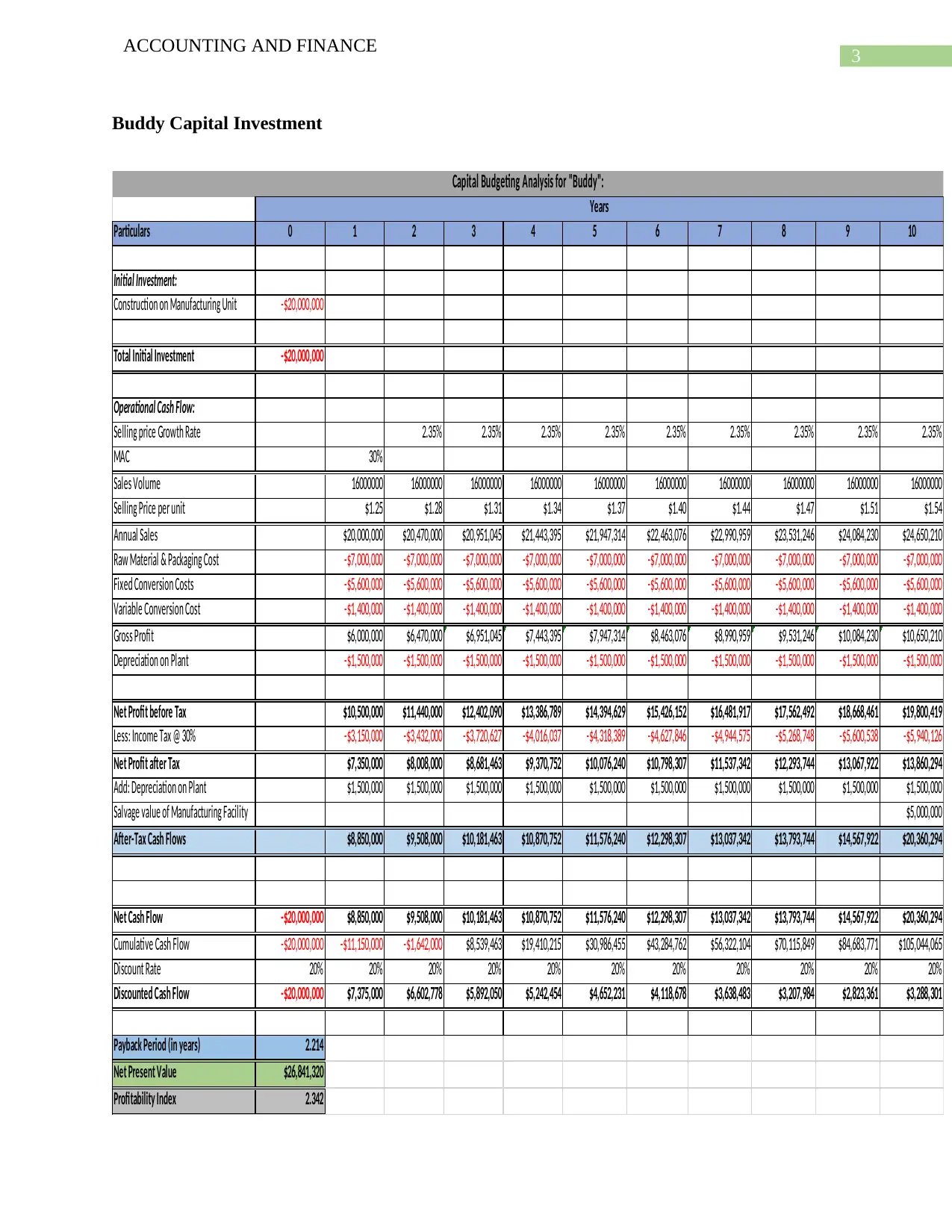
3
ACCOUNTING AND FINANCE
Buddy Capital Investment
Particulars 0 1 2 3 4 5 6 7 8 9 10
Initial Investment:
Construction on Manufacturing Unit -$20,000,000
Total Initial Investment -$20,000,000
Operational Cash Flow:
Selling price Growth Rate 2.35% 2.35% 2.35% 2.35% 2.35% 2.35% 2.35% 2.35% 2.35%
MAC 30%
Sales Volume 16000000 16000000 16000000 16000000 16000000 16000000 16000000 16000000 16000000 16000000
Selling Price per unit $1.25 $1.28 $1.31 $1.34 $1.37 $1.40 $1.44 $1.47 $1.51 $1.54
Annual Sales $20,000,000 $20,470,000 $20,951,045 $21,443,395 $21,947,314 $22,463,076 $22,990,959 $23,531,246 $24,084,230 $24,650,210
Raw Material & Packaging Cost -$7,000,000 -$7,000,000 -$7,000,000 -$7,000,000 -$7,000,000 -$7,000,000 -$7,000,000 -$7,000,000 -$7,000,000 -$7,000,000
Fixed Conversion Costs -$5,600,000 -$5,600,000 -$5,600,000 -$5,600,000 -$5,600,000 -$5,600,000 -$5,600,000 -$5,600,000 -$5,600,000 -$5,600,000
Variable Conversion Cost -$1,400,000 -$1,400,000 -$1,400,000 -$1,400,000 -$1,400,000 -$1,400,000 -$1,400,000 -$1,400,000 -$1,400,000 -$1,400,000
Gross Profit $6,000,000 $6,470,000 $6,951,045 $7,443,395 $7,947,314 $8,463,076 $8,990,959 $9,531,246 $10,084,230 $10,650,210
Depreciation on Plant -$1,500,000 -$1,500,000 -$1,500,000 -$1,500,000 -$1,500,000 -$1,500,000 -$1,500,000 -$1,500,000 -$1,500,000 -$1,500,000
Net Profit before Tax $10,500,000 $11,440,000 $12,402,090 $13,386,789 $14,394,629 $15,426,152 $16,481,917 $17,562,492 $18,668,461 $19,800,419
Less: Income Tax @ 30% -$3,150,000 -$3,432,000 -$3,720,627 -$4,016,037 -$4,318,389 -$4,627,846 -$4,944,575 -$5,268,748 -$5,600,538 -$5,940,126
Net Profit after Tax $7,350,000 $8,008,000 $8,681,463 $9,370,752 $10,076,240 $10,798,307 $11,537,342 $12,293,744 $13,067,922 $13,860,294
Add: Depreciation on Plant $1,500,000 $1,500,000 $1,500,000 $1,500,000 $1,500,000 $1,500,000 $1,500,000 $1,500,000 $1,500,000 $1,500,000
Salvage value of Manufacturing Facility $5,000,000
After-Tax Cash Flows $8,850,000 $9,508,000 $10,181,463 $10,870,752 $11,576,240 $12,298,307 $13,037,342 $13,793,744 $14,567,922 $20,360,294
Net Cash Flow -$20,000,000 $8,850,000 $9,508,000 $10,181,463 $10,870,752 $11,576,240 $12,298,307 $13,037,342 $13,793,744 $14,567,922 $20,360,294
Cumulative Cash Flow -$20,000,000 -$11,150,000 -$1,642,000 $8,539,463 $19,410,215 $30,986,455 $43,284,762 $56,322,104 $70,115,849 $84,683,771 $105,044,065
Discount Rate 20% 20% 20% 20% 20% 20% 20% 20% 20% 20% 20%
Discounted Cash Flow -$20,000,000 $7,375,000 $6,602,778 $5,892,050 $5,242,454 $4,652,231 $4,118,678 $3,638,483 $3,207,984 $2,823,361 $3,288,301
Payback Period (in years) 2.214
Net Present Value $26,841,320
Profitability Index 2.342
Years
Capital Budgeting Analysis for "Buddy":
ACCOUNTING AND FINANCE
Buddy Capital Investment
Particulars 0 1 2 3 4 5 6 7 8 9 10
Initial Investment:
Construction on Manufacturing Unit -$20,000,000
Total Initial Investment -$20,000,000
Operational Cash Flow:
Selling price Growth Rate 2.35% 2.35% 2.35% 2.35% 2.35% 2.35% 2.35% 2.35% 2.35%
MAC 30%
Sales Volume 16000000 16000000 16000000 16000000 16000000 16000000 16000000 16000000 16000000 16000000
Selling Price per unit $1.25 $1.28 $1.31 $1.34 $1.37 $1.40 $1.44 $1.47 $1.51 $1.54
Annual Sales $20,000,000 $20,470,000 $20,951,045 $21,443,395 $21,947,314 $22,463,076 $22,990,959 $23,531,246 $24,084,230 $24,650,210
Raw Material & Packaging Cost -$7,000,000 -$7,000,000 -$7,000,000 -$7,000,000 -$7,000,000 -$7,000,000 -$7,000,000 -$7,000,000 -$7,000,000 -$7,000,000
Fixed Conversion Costs -$5,600,000 -$5,600,000 -$5,600,000 -$5,600,000 -$5,600,000 -$5,600,000 -$5,600,000 -$5,600,000 -$5,600,000 -$5,600,000
Variable Conversion Cost -$1,400,000 -$1,400,000 -$1,400,000 -$1,400,000 -$1,400,000 -$1,400,000 -$1,400,000 -$1,400,000 -$1,400,000 -$1,400,000
Gross Profit $6,000,000 $6,470,000 $6,951,045 $7,443,395 $7,947,314 $8,463,076 $8,990,959 $9,531,246 $10,084,230 $10,650,210
Depreciation on Plant -$1,500,000 -$1,500,000 -$1,500,000 -$1,500,000 -$1,500,000 -$1,500,000 -$1,500,000 -$1,500,000 -$1,500,000 -$1,500,000
Net Profit before Tax $10,500,000 $11,440,000 $12,402,090 $13,386,789 $14,394,629 $15,426,152 $16,481,917 $17,562,492 $18,668,461 $19,800,419
Less: Income Tax @ 30% -$3,150,000 -$3,432,000 -$3,720,627 -$4,016,037 -$4,318,389 -$4,627,846 -$4,944,575 -$5,268,748 -$5,600,538 -$5,940,126
Net Profit after Tax $7,350,000 $8,008,000 $8,681,463 $9,370,752 $10,076,240 $10,798,307 $11,537,342 $12,293,744 $13,067,922 $13,860,294
Add: Depreciation on Plant $1,500,000 $1,500,000 $1,500,000 $1,500,000 $1,500,000 $1,500,000 $1,500,000 $1,500,000 $1,500,000 $1,500,000
Salvage value of Manufacturing Facility $5,000,000
After-Tax Cash Flows $8,850,000 $9,508,000 $10,181,463 $10,870,752 $11,576,240 $12,298,307 $13,037,342 $13,793,744 $14,567,922 $20,360,294
Net Cash Flow -$20,000,000 $8,850,000 $9,508,000 $10,181,463 $10,870,752 $11,576,240 $12,298,307 $13,037,342 $13,793,744 $14,567,922 $20,360,294
Cumulative Cash Flow -$20,000,000 -$11,150,000 -$1,642,000 $8,539,463 $19,410,215 $30,986,455 $43,284,762 $56,322,104 $70,115,849 $84,683,771 $105,044,065
Discount Rate 20% 20% 20% 20% 20% 20% 20% 20% 20% 20% 20%
Discounted Cash Flow -$20,000,000 $7,375,000 $6,602,778 $5,892,050 $5,242,454 $4,652,231 $4,118,678 $3,638,483 $3,207,984 $2,823,361 $3,288,301
Payback Period (in years) 2.214
Net Present Value $26,841,320
Profitability Index 2.342
Years
Capital Budgeting Analysis for "Buddy":
Secure Best Marks with AI Grader
Need help grading? Try our AI Grader for instant feedback on your assignments.
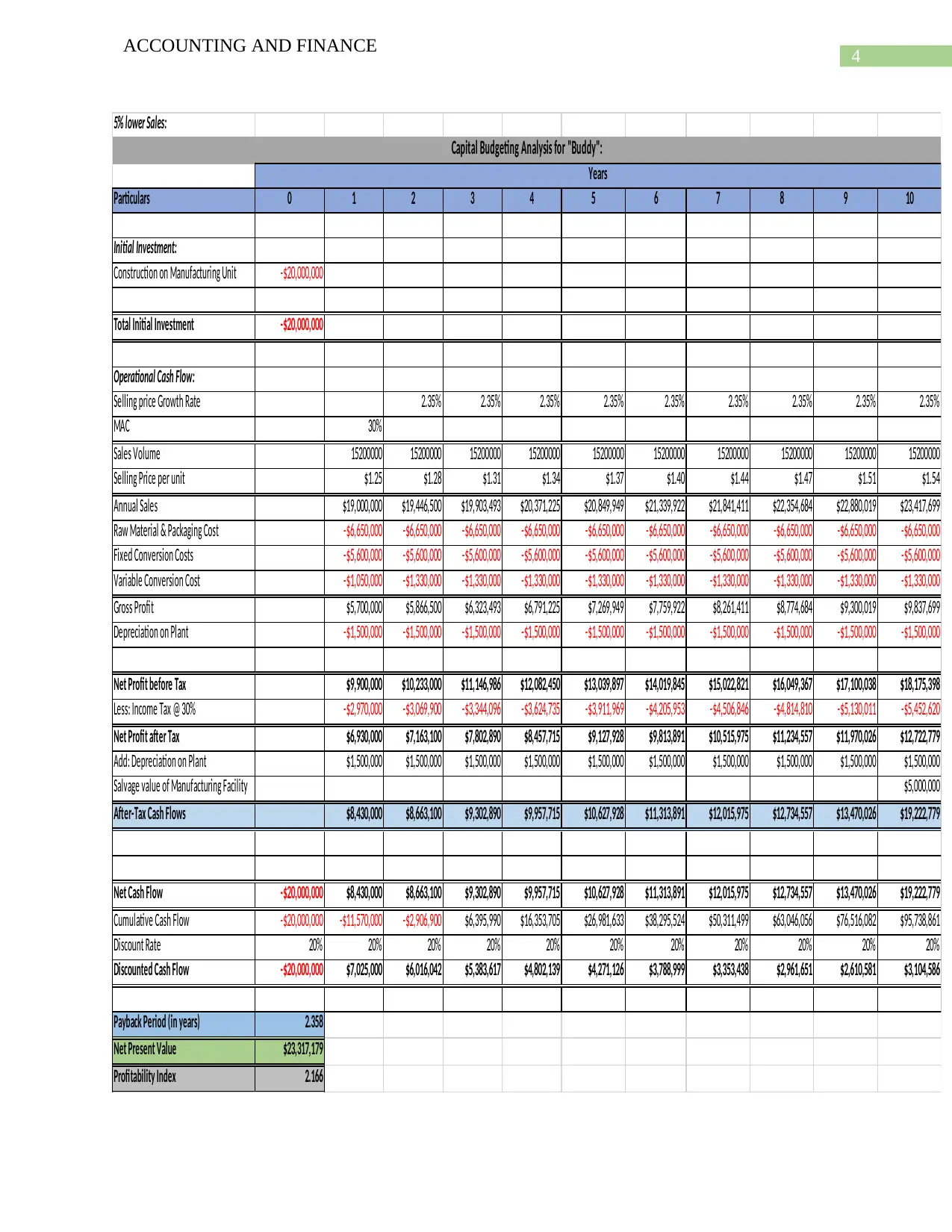
4
ACCOUNTING AND FINANCE
5% lower Sales:
Particulars 0 1 2 3 4 5 6 7 8 9 10
Initial Investment:
Construction on Manufacturing Unit -$20,000,000
Total Initial Investment -$20,000,000
Operational Cash Flow:
Selling price Growth Rate 2.35% 2.35% 2.35% 2.35% 2.35% 2.35% 2.35% 2.35% 2.35%
MAC 30%
Sales Volume 15200000 15200000 15200000 15200000 15200000 15200000 15200000 15200000 15200000 15200000
Selling Price per unit $1.25 $1.28 $1.31 $1.34 $1.37 $1.40 $1.44 $1.47 $1.51 $1.54
Annual Sales $19,000,000 $19,446,500 $19,903,493 $20,371,225 $20,849,949 $21,339,922 $21,841,411 $22,354,684 $22,880,019 $23,417,699
Raw Material & Packaging Cost -$6,650,000 -$6,650,000 -$6,650,000 -$6,650,000 -$6,650,000 -$6,650,000 -$6,650,000 -$6,650,000 -$6,650,000 -$6,650,000
Fixed Conversion Costs -$5,600,000 -$5,600,000 -$5,600,000 -$5,600,000 -$5,600,000 -$5,600,000 -$5,600,000 -$5,600,000 -$5,600,000 -$5,600,000
Variable Conversion Cost -$1,050,000 -$1,330,000 -$1,330,000 -$1,330,000 -$1,330,000 -$1,330,000 -$1,330,000 -$1,330,000 -$1,330,000 -$1,330,000
Gross Profit $5,700,000 $5,866,500 $6,323,493 $6,791,225 $7,269,949 $7,759,922 $8,261,411 $8,774,684 $9,300,019 $9,837,699
Depreciation on Plant -$1,500,000 -$1,500,000 -$1,500,000 -$1,500,000 -$1,500,000 -$1,500,000 -$1,500,000 -$1,500,000 -$1,500,000 -$1,500,000
Net Profit before Tax $9,900,000 $10,233,000 $11,146,986 $12,082,450 $13,039,897 $14,019,845 $15,022,821 $16,049,367 $17,100,038 $18,175,398
Less: Income Tax @ 30% -$2,970,000 -$3,069,900 -$3,344,096 -$3,624,735 -$3,911,969 -$4,205,953 -$4,506,846 -$4,814,810 -$5,130,011 -$5,452,620
Net Profit after Tax $6,930,000 $7,163,100 $7,802,890 $8,457,715 $9,127,928 $9,813,891 $10,515,975 $11,234,557 $11,970,026 $12,722,779
Add: Depreciation on Plant $1,500,000 $1,500,000 $1,500,000 $1,500,000 $1,500,000 $1,500,000 $1,500,000 $1,500,000 $1,500,000 $1,500,000
Salvage value of Manufacturing Facility $5,000,000
After-Tax Cash Flows $8,430,000 $8,663,100 $9,302,890 $9,957,715 $10,627,928 $11,313,891 $12,015,975 $12,734,557 $13,470,026 $19,222,779
Net Cash Flow -$20,000,000 $8,430,000 $8,663,100 $9,302,890 $9,957,715 $10,627,928 $11,313,891 $12,015,975 $12,734,557 $13,470,026 $19,222,779
Cumulative Cash Flow -$20,000,000 -$11,570,000 -$2,906,900 $6,395,990 $16,353,705 $26,981,633 $38,295,524 $50,311,499 $63,046,056 $76,516,082 $95,738,861
Discount Rate 20% 20% 20% 20% 20% 20% 20% 20% 20% 20% 20%
Discounted Cash Flow -$20,000,000 $7,025,000 $6,016,042 $5,383,617 $4,802,139 $4,271,126 $3,788,999 $3,353,438 $2,961,651 $2,610,581 $3,104,586
Payback Period (in years) 2.358
Net Present Value $23,317,179
Profitability Index 2.166
Capital Budgeting Analysis for "Buddy":
Years
ACCOUNTING AND FINANCE
5% lower Sales:
Particulars 0 1 2 3 4 5 6 7 8 9 10
Initial Investment:
Construction on Manufacturing Unit -$20,000,000
Total Initial Investment -$20,000,000
Operational Cash Flow:
Selling price Growth Rate 2.35% 2.35% 2.35% 2.35% 2.35% 2.35% 2.35% 2.35% 2.35%
MAC 30%
Sales Volume 15200000 15200000 15200000 15200000 15200000 15200000 15200000 15200000 15200000 15200000
Selling Price per unit $1.25 $1.28 $1.31 $1.34 $1.37 $1.40 $1.44 $1.47 $1.51 $1.54
Annual Sales $19,000,000 $19,446,500 $19,903,493 $20,371,225 $20,849,949 $21,339,922 $21,841,411 $22,354,684 $22,880,019 $23,417,699
Raw Material & Packaging Cost -$6,650,000 -$6,650,000 -$6,650,000 -$6,650,000 -$6,650,000 -$6,650,000 -$6,650,000 -$6,650,000 -$6,650,000 -$6,650,000
Fixed Conversion Costs -$5,600,000 -$5,600,000 -$5,600,000 -$5,600,000 -$5,600,000 -$5,600,000 -$5,600,000 -$5,600,000 -$5,600,000 -$5,600,000
Variable Conversion Cost -$1,050,000 -$1,330,000 -$1,330,000 -$1,330,000 -$1,330,000 -$1,330,000 -$1,330,000 -$1,330,000 -$1,330,000 -$1,330,000
Gross Profit $5,700,000 $5,866,500 $6,323,493 $6,791,225 $7,269,949 $7,759,922 $8,261,411 $8,774,684 $9,300,019 $9,837,699
Depreciation on Plant -$1,500,000 -$1,500,000 -$1,500,000 -$1,500,000 -$1,500,000 -$1,500,000 -$1,500,000 -$1,500,000 -$1,500,000 -$1,500,000
Net Profit before Tax $9,900,000 $10,233,000 $11,146,986 $12,082,450 $13,039,897 $14,019,845 $15,022,821 $16,049,367 $17,100,038 $18,175,398
Less: Income Tax @ 30% -$2,970,000 -$3,069,900 -$3,344,096 -$3,624,735 -$3,911,969 -$4,205,953 -$4,506,846 -$4,814,810 -$5,130,011 -$5,452,620
Net Profit after Tax $6,930,000 $7,163,100 $7,802,890 $8,457,715 $9,127,928 $9,813,891 $10,515,975 $11,234,557 $11,970,026 $12,722,779
Add: Depreciation on Plant $1,500,000 $1,500,000 $1,500,000 $1,500,000 $1,500,000 $1,500,000 $1,500,000 $1,500,000 $1,500,000 $1,500,000
Salvage value of Manufacturing Facility $5,000,000
After-Tax Cash Flows $8,430,000 $8,663,100 $9,302,890 $9,957,715 $10,627,928 $11,313,891 $12,015,975 $12,734,557 $13,470,026 $19,222,779
Net Cash Flow -$20,000,000 $8,430,000 $8,663,100 $9,302,890 $9,957,715 $10,627,928 $11,313,891 $12,015,975 $12,734,557 $13,470,026 $19,222,779
Cumulative Cash Flow -$20,000,000 -$11,570,000 -$2,906,900 $6,395,990 $16,353,705 $26,981,633 $38,295,524 $50,311,499 $63,046,056 $76,516,082 $95,738,861
Discount Rate 20% 20% 20% 20% 20% 20% 20% 20% 20% 20% 20%
Discounted Cash Flow -$20,000,000 $7,025,000 $6,016,042 $5,383,617 $4,802,139 $4,271,126 $3,788,999 $3,353,438 $2,961,651 $2,610,581 $3,104,586
Payback Period (in years) 2.358
Net Present Value $23,317,179
Profitability Index 2.166
Capital Budgeting Analysis for "Buddy":
Years
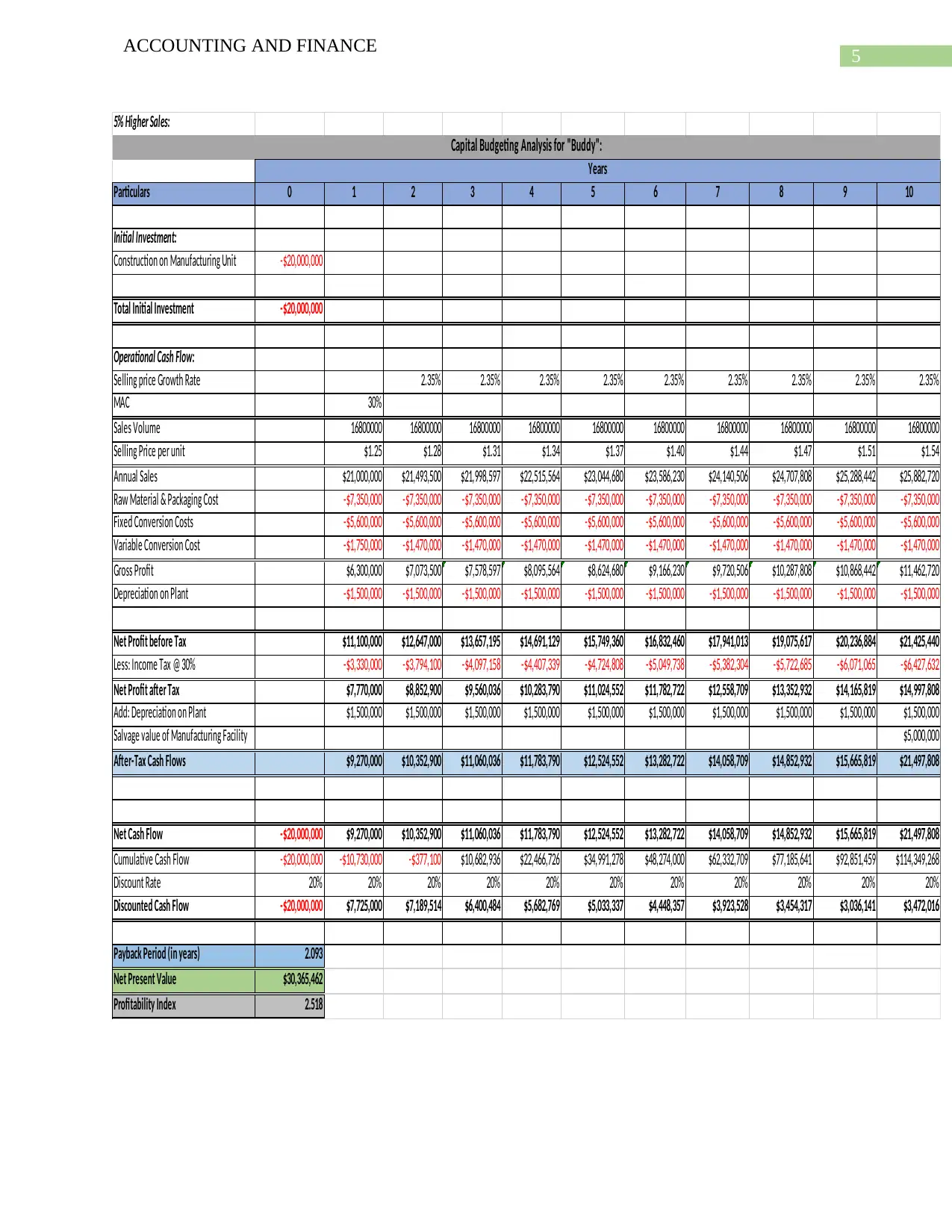
5
ACCOUNTING AND FINANCE
5% Higher Sales:
Particulars 0 1 2 3 4 5 6 7 8 9 10
Initial Investment:
Construction on Manufacturing Unit -$20,000,000
Total Initial Investment -$20,000,000
Operational Cash Flow:
Selling price Growth Rate 2.35% 2.35% 2.35% 2.35% 2.35% 2.35% 2.35% 2.35% 2.35%
MAC 30%
Sales Volume 16800000 16800000 16800000 16800000 16800000 16800000 16800000 16800000 16800000 16800000
Selling Price per unit $1.25 $1.28 $1.31 $1.34 $1.37 $1.40 $1.44 $1.47 $1.51 $1.54
Annual Sales $21,000,000 $21,493,500 $21,998,597 $22,515,564 $23,044,680 $23,586,230 $24,140,506 $24,707,808 $25,288,442 $25,882,720
Raw Material & Packaging Cost -$7,350,000 -$7,350,000 -$7,350,000 -$7,350,000 -$7,350,000 -$7,350,000 -$7,350,000 -$7,350,000 -$7,350,000 -$7,350,000
Fixed Conversion Costs -$5,600,000 -$5,600,000 -$5,600,000 -$5,600,000 -$5,600,000 -$5,600,000 -$5,600,000 -$5,600,000 -$5,600,000 -$5,600,000
Variable Conversion Cost -$1,750,000 -$1,470,000 -$1,470,000 -$1,470,000 -$1,470,000 -$1,470,000 -$1,470,000 -$1,470,000 -$1,470,000 -$1,470,000
Gross Profit $6,300,000 $7,073,500 $7,578,597 $8,095,564 $8,624,680 $9,166,230 $9,720,506 $10,287,808 $10,868,442 $11,462,720
Depreciation on Plant -$1,500,000 -$1,500,000 -$1,500,000 -$1,500,000 -$1,500,000 -$1,500,000 -$1,500,000 -$1,500,000 -$1,500,000 -$1,500,000
Net Profit before Tax $11,100,000 $12,647,000 $13,657,195 $14,691,129 $15,749,360 $16,832,460 $17,941,013 $19,075,617 $20,236,884 $21,425,440
Less: Income Tax @ 30% -$3,330,000 -$3,794,100 -$4,097,158 -$4,407,339 -$4,724,808 -$5,049,738 -$5,382,304 -$5,722,685 -$6,071,065 -$6,427,632
Net Profit after Tax $7,770,000 $8,852,900 $9,560,036 $10,283,790 $11,024,552 $11,782,722 $12,558,709 $13,352,932 $14,165,819 $14,997,808
Add: Depreciation on Plant $1,500,000 $1,500,000 $1,500,000 $1,500,000 $1,500,000 $1,500,000 $1,500,000 $1,500,000 $1,500,000 $1,500,000
Salvage value of Manufacturing Facility $5,000,000
After-Tax Cash Flows $9,270,000 $10,352,900 $11,060,036 $11,783,790 $12,524,552 $13,282,722 $14,058,709 $14,852,932 $15,665,819 $21,497,808
Net Cash Flow -$20,000,000 $9,270,000 $10,352,900 $11,060,036 $11,783,790 $12,524,552 $13,282,722 $14,058,709 $14,852,932 $15,665,819 $21,497,808
Cumulative Cash Flow -$20,000,000 -$10,730,000 -$377,100 $10,682,936 $22,466,726 $34,991,278 $48,274,000 $62,332,709 $77,185,641 $92,851,459 $114,349,268
Discount Rate 20% 20% 20% 20% 20% 20% 20% 20% 20% 20% 20%
Discounted Cash Flow -$20,000,000 $7,725,000 $7,189,514 $6,400,484 $5,682,769 $5,033,337 $4,448,357 $3,923,528 $3,454,317 $3,036,141 $3,472,016
Payback Period (in years) 2.093
Net Present Value $30,365,462
Profitability Index 2.518
Years
Capital Budgeting Analysis for "Buddy":
ACCOUNTING AND FINANCE
5% Higher Sales:
Particulars 0 1 2 3 4 5 6 7 8 9 10
Initial Investment:
Construction on Manufacturing Unit -$20,000,000
Total Initial Investment -$20,000,000
Operational Cash Flow:
Selling price Growth Rate 2.35% 2.35% 2.35% 2.35% 2.35% 2.35% 2.35% 2.35% 2.35%
MAC 30%
Sales Volume 16800000 16800000 16800000 16800000 16800000 16800000 16800000 16800000 16800000 16800000
Selling Price per unit $1.25 $1.28 $1.31 $1.34 $1.37 $1.40 $1.44 $1.47 $1.51 $1.54
Annual Sales $21,000,000 $21,493,500 $21,998,597 $22,515,564 $23,044,680 $23,586,230 $24,140,506 $24,707,808 $25,288,442 $25,882,720
Raw Material & Packaging Cost -$7,350,000 -$7,350,000 -$7,350,000 -$7,350,000 -$7,350,000 -$7,350,000 -$7,350,000 -$7,350,000 -$7,350,000 -$7,350,000
Fixed Conversion Costs -$5,600,000 -$5,600,000 -$5,600,000 -$5,600,000 -$5,600,000 -$5,600,000 -$5,600,000 -$5,600,000 -$5,600,000 -$5,600,000
Variable Conversion Cost -$1,750,000 -$1,470,000 -$1,470,000 -$1,470,000 -$1,470,000 -$1,470,000 -$1,470,000 -$1,470,000 -$1,470,000 -$1,470,000
Gross Profit $6,300,000 $7,073,500 $7,578,597 $8,095,564 $8,624,680 $9,166,230 $9,720,506 $10,287,808 $10,868,442 $11,462,720
Depreciation on Plant -$1,500,000 -$1,500,000 -$1,500,000 -$1,500,000 -$1,500,000 -$1,500,000 -$1,500,000 -$1,500,000 -$1,500,000 -$1,500,000
Net Profit before Tax $11,100,000 $12,647,000 $13,657,195 $14,691,129 $15,749,360 $16,832,460 $17,941,013 $19,075,617 $20,236,884 $21,425,440
Less: Income Tax @ 30% -$3,330,000 -$3,794,100 -$4,097,158 -$4,407,339 -$4,724,808 -$5,049,738 -$5,382,304 -$5,722,685 -$6,071,065 -$6,427,632
Net Profit after Tax $7,770,000 $8,852,900 $9,560,036 $10,283,790 $11,024,552 $11,782,722 $12,558,709 $13,352,932 $14,165,819 $14,997,808
Add: Depreciation on Plant $1,500,000 $1,500,000 $1,500,000 $1,500,000 $1,500,000 $1,500,000 $1,500,000 $1,500,000 $1,500,000 $1,500,000
Salvage value of Manufacturing Facility $5,000,000
After-Tax Cash Flows $9,270,000 $10,352,900 $11,060,036 $11,783,790 $12,524,552 $13,282,722 $14,058,709 $14,852,932 $15,665,819 $21,497,808
Net Cash Flow -$20,000,000 $9,270,000 $10,352,900 $11,060,036 $11,783,790 $12,524,552 $13,282,722 $14,058,709 $14,852,932 $15,665,819 $21,497,808
Cumulative Cash Flow -$20,000,000 -$10,730,000 -$377,100 $10,682,936 $22,466,726 $34,991,278 $48,274,000 $62,332,709 $77,185,641 $92,851,459 $114,349,268
Discount Rate 20% 20% 20% 20% 20% 20% 20% 20% 20% 20% 20%
Discounted Cash Flow -$20,000,000 $7,725,000 $7,189,514 $6,400,484 $5,682,769 $5,033,337 $4,448,357 $3,923,528 $3,454,317 $3,036,141 $3,472,016
Payback Period (in years) 2.093
Net Present Value $30,365,462
Profitability Index 2.518
Years
Capital Budgeting Analysis for "Buddy":
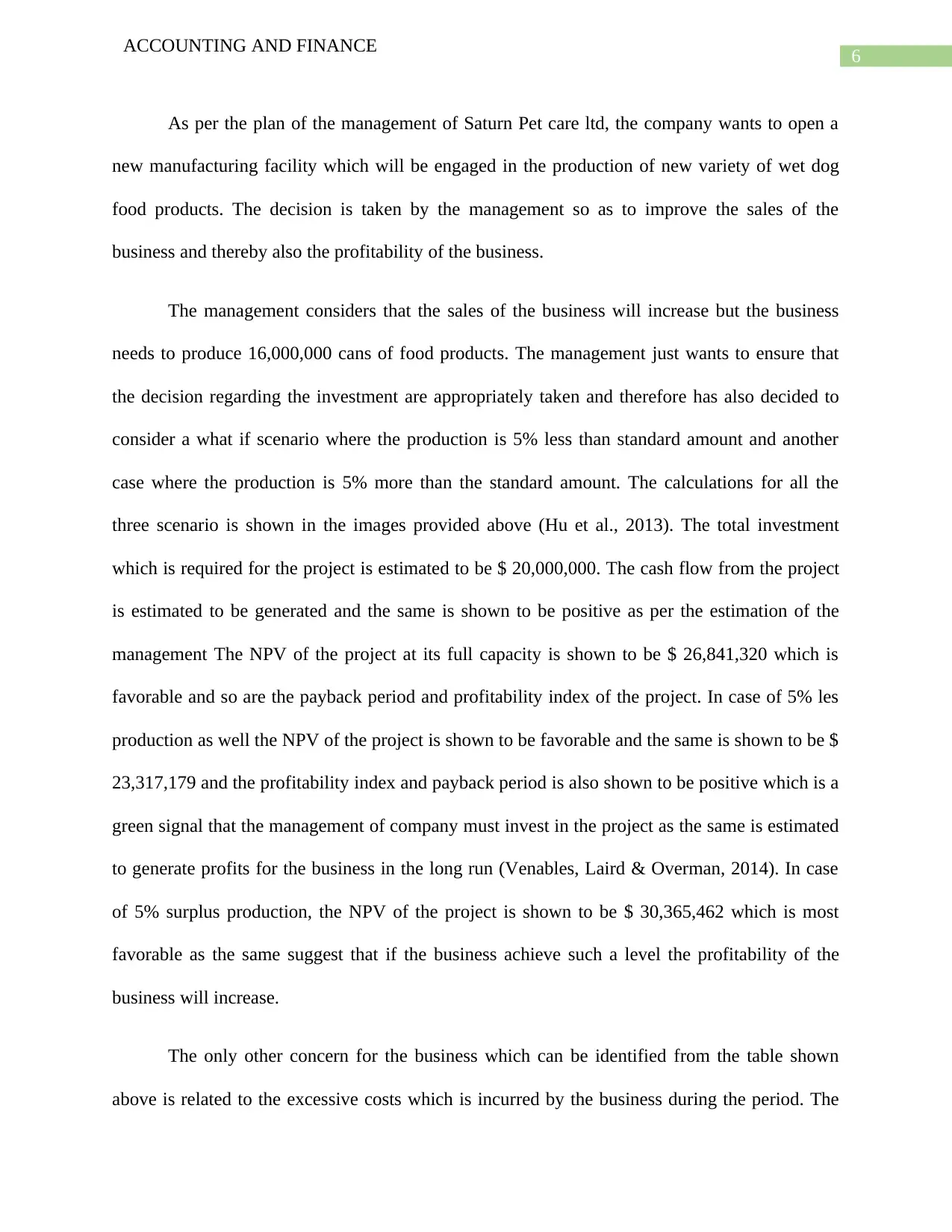
6
ACCOUNTING AND FINANCE
As per the plan of the management of Saturn Pet care ltd, the company wants to open a
new manufacturing facility which will be engaged in the production of new variety of wet dog
food products. The decision is taken by the management so as to improve the sales of the
business and thereby also the profitability of the business.
The management considers that the sales of the business will increase but the business
needs to produce 16,000,000 cans of food products. The management just wants to ensure that
the decision regarding the investment are appropriately taken and therefore has also decided to
consider a what if scenario where the production is 5% less than standard amount and another
case where the production is 5% more than the standard amount. The calculations for all the
three scenario is shown in the images provided above (Hu et al., 2013). The total investment
which is required for the project is estimated to be $ 20,000,000. The cash flow from the project
is estimated to be generated and the same is shown to be positive as per the estimation of the
management The NPV of the project at its full capacity is shown to be $ 26,841,320 which is
favorable and so are the payback period and profitability index of the project. In case of 5% les
production as well the NPV of the project is shown to be favorable and the same is shown to be $
23,317,179 and the profitability index and payback period is also shown to be positive which is a
green signal that the management of company must invest in the project as the same is estimated
to generate profits for the business in the long run (Venables, Laird & Overman, 2014). In case
of 5% surplus production, the NPV of the project is shown to be $ 30,365,462 which is most
favorable as the same suggest that if the business achieve such a level the profitability of the
business will increase.
The only other concern for the business which can be identified from the table shown
above is related to the excessive costs which is incurred by the business during the period. The
ACCOUNTING AND FINANCE
As per the plan of the management of Saturn Pet care ltd, the company wants to open a
new manufacturing facility which will be engaged in the production of new variety of wet dog
food products. The decision is taken by the management so as to improve the sales of the
business and thereby also the profitability of the business.
The management considers that the sales of the business will increase but the business
needs to produce 16,000,000 cans of food products. The management just wants to ensure that
the decision regarding the investment are appropriately taken and therefore has also decided to
consider a what if scenario where the production is 5% less than standard amount and another
case where the production is 5% more than the standard amount. The calculations for all the
three scenario is shown in the images provided above (Hu et al., 2013). The total investment
which is required for the project is estimated to be $ 20,000,000. The cash flow from the project
is estimated to be generated and the same is shown to be positive as per the estimation of the
management The NPV of the project at its full capacity is shown to be $ 26,841,320 which is
favorable and so are the payback period and profitability index of the project. In case of 5% les
production as well the NPV of the project is shown to be favorable and the same is shown to be $
23,317,179 and the profitability index and payback period is also shown to be positive which is a
green signal that the management of company must invest in the project as the same is estimated
to generate profits for the business in the long run (Venables, Laird & Overman, 2014). In case
of 5% surplus production, the NPV of the project is shown to be $ 30,365,462 which is most
favorable as the same suggest that if the business achieve such a level the profitability of the
business will increase.
The only other concern for the business which can be identified from the table shown
above is related to the excessive costs which is incurred by the business during the period. The
Paraphrase This Document
Need a fresh take? Get an instant paraphrase of this document with our AI Paraphraser
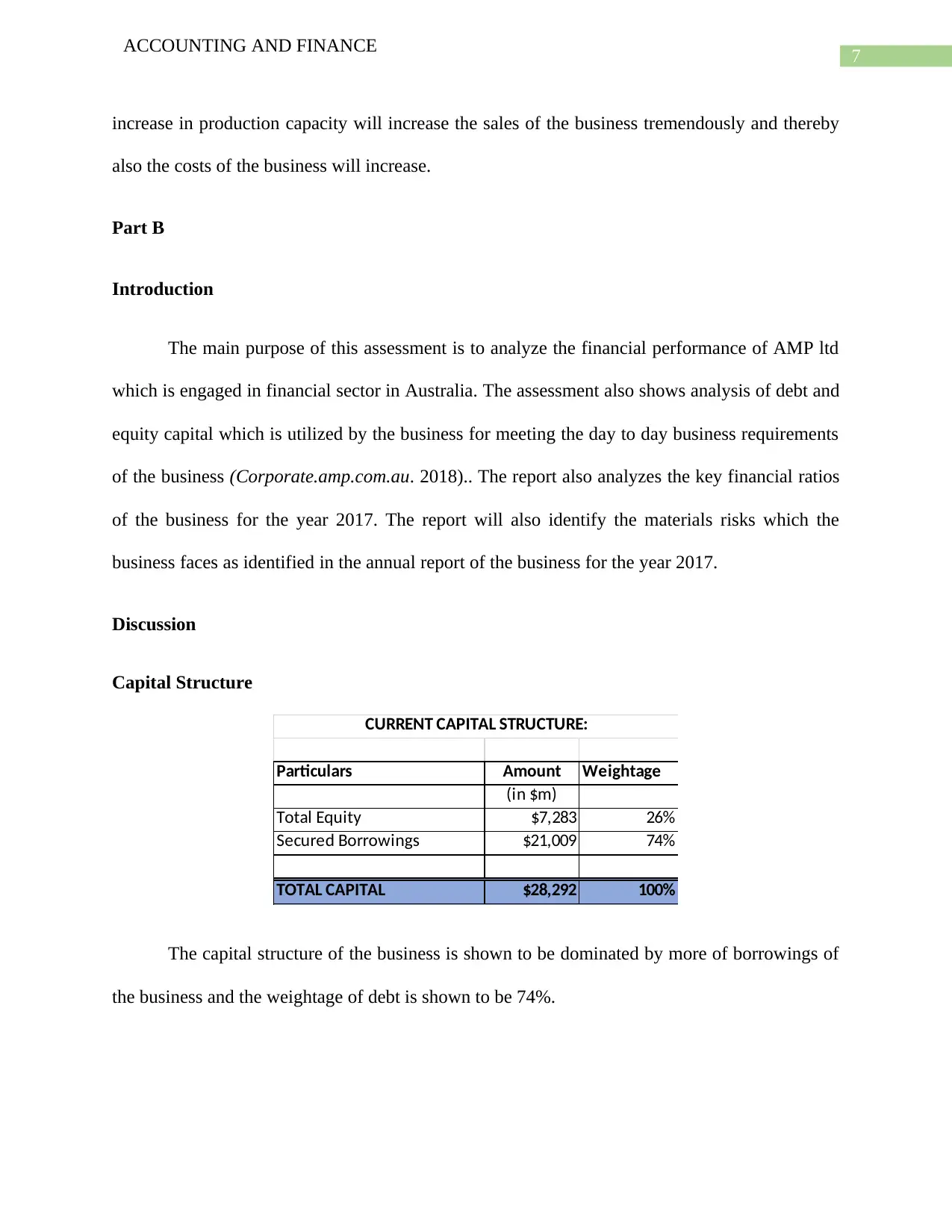
7
ACCOUNTING AND FINANCE
increase in production capacity will increase the sales of the business tremendously and thereby
also the costs of the business will increase.
Part B
Introduction
The main purpose of this assessment is to analyze the financial performance of AMP ltd
which is engaged in financial sector in Australia. The assessment also shows analysis of debt and
equity capital which is utilized by the business for meeting the day to day business requirements
of the business (Corporate.amp.com.au. 2018).. The report also analyzes the key financial ratios
of the business for the year 2017. The report will also identify the materials risks which the
business faces as identified in the annual report of the business for the year 2017.
Discussion
Capital Structure
Particulars Amount Weightage
(in $m)
Total Equity $7,283 26%
Secured Borrowings $21,009 74%
TOTAL CAPITAL $28,292 100%
CURRENT CAPITAL STRUCTURE:
The capital structure of the business is shown to be dominated by more of borrowings of
the business and the weightage of debt is shown to be 74%.
ACCOUNTING AND FINANCE
increase in production capacity will increase the sales of the business tremendously and thereby
also the costs of the business will increase.
Part B
Introduction
The main purpose of this assessment is to analyze the financial performance of AMP ltd
which is engaged in financial sector in Australia. The assessment also shows analysis of debt and
equity capital which is utilized by the business for meeting the day to day business requirements
of the business (Corporate.amp.com.au. 2018).. The report also analyzes the key financial ratios
of the business for the year 2017. The report will also identify the materials risks which the
business faces as identified in the annual report of the business for the year 2017.
Discussion
Capital Structure
Particulars Amount Weightage
(in $m)
Total Equity $7,283 26%
Secured Borrowings $21,009 74%
TOTAL CAPITAL $28,292 100%
CURRENT CAPITAL STRUCTURE:
The capital structure of the business is shown to be dominated by more of borrowings of
the business and the weightage of debt is shown to be 74%.
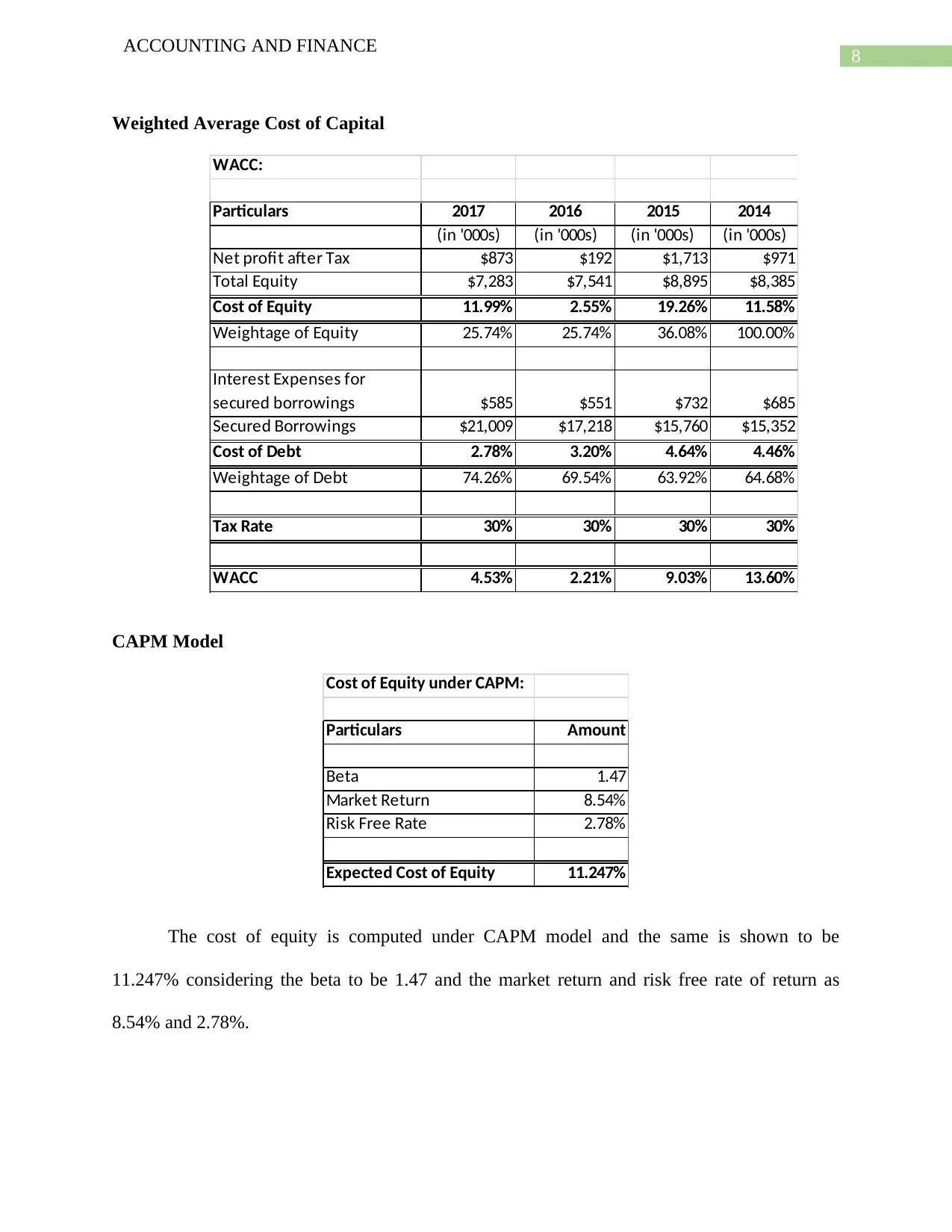
8
ACCOUNTING AND FINANCE
Weighted Average Cost of Capital
WACC:
Particulars 2017 2016 2015 2014
(in '000s) (in '000s) (in '000s) (in '000s)
Net profit after Tax $873 $192 $1,713 $971
Total Equity $7,283 $7,541 $8,895 $8,385
Cost of Equity 11.99% 2.55% 19.26% 11.58%
Weightage of Equity 25.74% 25.74% 36.08% 100.00%
Interest Expenses for
secured borrowings $585 $551 $732 $685
Secured Borrowings $21,009 $17,218 $15,760 $15,352
Cost of Debt 2.78% 3.20% 4.64% 4.46%
Weightage of Debt 74.26% 69.54% 63.92% 64.68%
Tax Rate 30% 30% 30% 30%
WACC 4.53% 2.21% 9.03% 13.60%
CAPM Model
Cost of Equity under CAPM:
Particulars Amount
Beta 1.47
Market Return 8.54%
Risk Free Rate 2.78%
Expected Cost of Equity 11.247%
The cost of equity is computed under CAPM model and the same is shown to be
11.247% considering the beta to be 1.47 and the market return and risk free rate of return as
8.54% and 2.78%.
ACCOUNTING AND FINANCE
Weighted Average Cost of Capital
WACC:
Particulars 2017 2016 2015 2014
(in '000s) (in '000s) (in '000s) (in '000s)
Net profit after Tax $873 $192 $1,713 $971
Total Equity $7,283 $7,541 $8,895 $8,385
Cost of Equity 11.99% 2.55% 19.26% 11.58%
Weightage of Equity 25.74% 25.74% 36.08% 100.00%
Interest Expenses for
secured borrowings $585 $551 $732 $685
Secured Borrowings $21,009 $17,218 $15,760 $15,352
Cost of Debt 2.78% 3.20% 4.64% 4.46%
Weightage of Debt 74.26% 69.54% 63.92% 64.68%
Tax Rate 30% 30% 30% 30%
WACC 4.53% 2.21% 9.03% 13.60%
CAPM Model
Cost of Equity under CAPM:
Particulars Amount
Beta 1.47
Market Return 8.54%
Risk Free Rate 2.78%
Expected Cost of Equity 11.247%
The cost of equity is computed under CAPM model and the same is shown to be
11.247% considering the beta to be 1.47 and the market return and risk free rate of return as
8.54% and 2.78%.
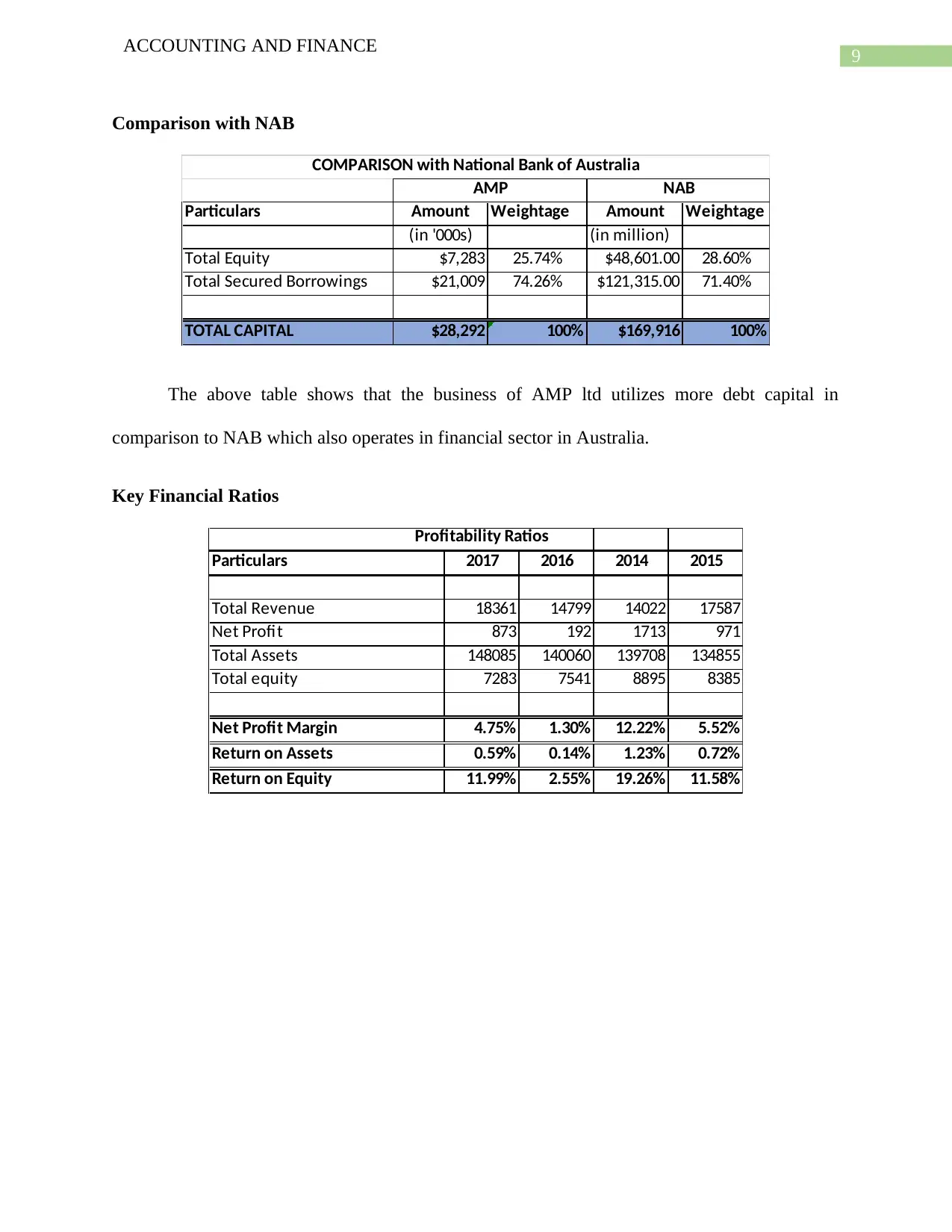
9
ACCOUNTING AND FINANCE
Comparison with NAB
Particulars Amount Weightage Amount Weightage
(in '000s) (in million)
Total Equity $7,283 25.74% $48,601.00 28.60%
Total Secured Borrowings $21,009 74.26% $121,315.00 71.40%
TOTAL CAPITAL $28,292 100% $169,916 100%
AMP NAB
COMPARISON with National Bank of Australia
The above table shows that the business of AMP ltd utilizes more debt capital in
comparison to NAB which also operates in financial sector in Australia.
Key Financial Ratios
Profitability Ratios
Particulars 2017 2016 2014 2015
Total Revenue 18361 14799 14022 17587
Net Profit 873 192 1713 971
Total Assets 148085 140060 139708 134855
Total equity 7283 7541 8895 8385
Net Profit Margin 4.75% 1.30% 12.22% 5.52%
Return on Assets 0.59% 0.14% 1.23% 0.72%
Return on Equity 11.99% 2.55% 19.26% 11.58%
ACCOUNTING AND FINANCE
Comparison with NAB
Particulars Amount Weightage Amount Weightage
(in '000s) (in million)
Total Equity $7,283 25.74% $48,601.00 28.60%
Total Secured Borrowings $21,009 74.26% $121,315.00 71.40%
TOTAL CAPITAL $28,292 100% $169,916 100%
AMP NAB
COMPARISON with National Bank of Australia
The above table shows that the business of AMP ltd utilizes more debt capital in
comparison to NAB which also operates in financial sector in Australia.
Key Financial Ratios
Profitability Ratios
Particulars 2017 2016 2014 2015
Total Revenue 18361 14799 14022 17587
Net Profit 873 192 1713 971
Total Assets 148085 140060 139708 134855
Total equity 7283 7541 8895 8385
Net Profit Margin 4.75% 1.30% 12.22% 5.52%
Return on Assets 0.59% 0.14% 1.23% 0.72%
Return on Equity 11.99% 2.55% 19.26% 11.58%
Secure Best Marks with AI Grader
Need help grading? Try our AI Grader for instant feedback on your assignments.
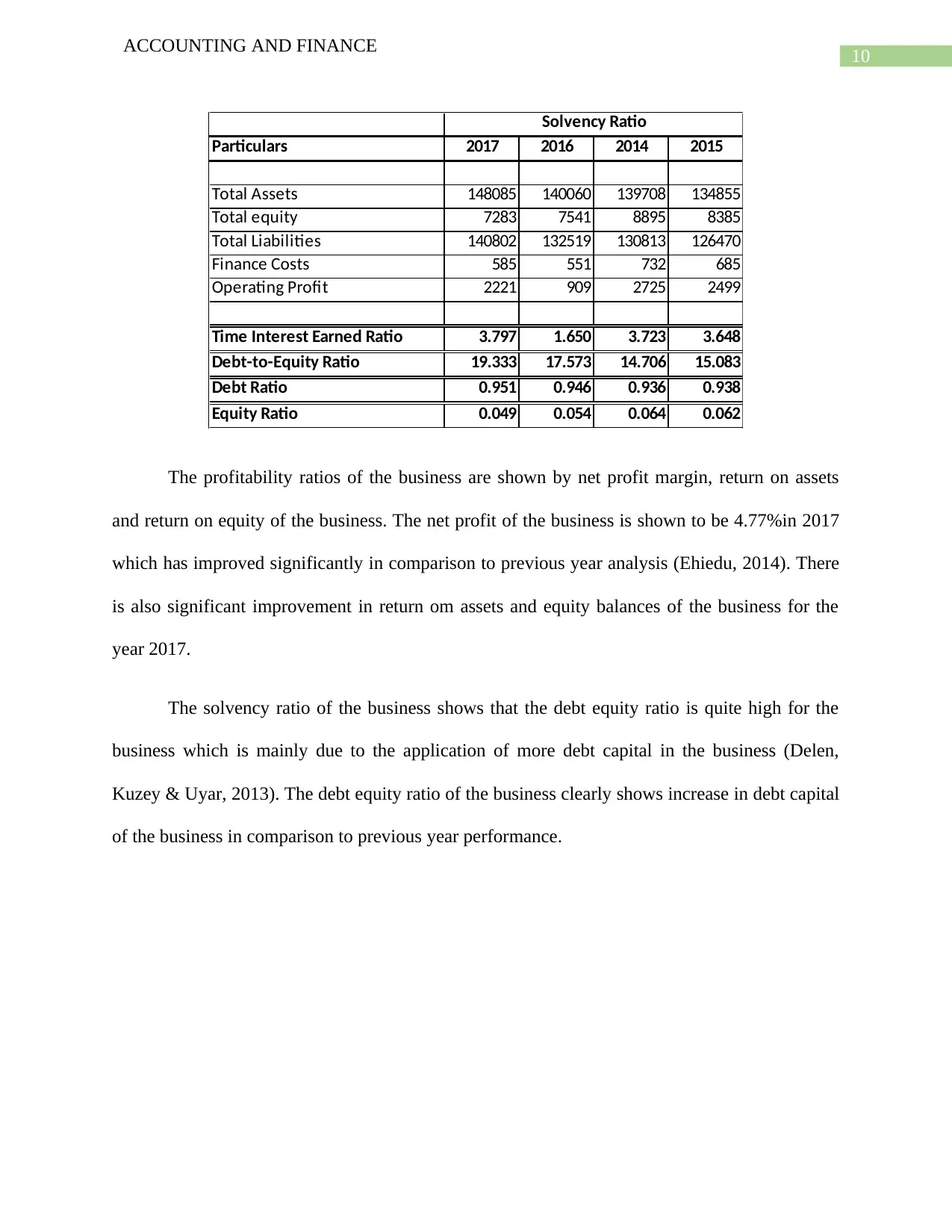
10
ACCOUNTING AND FINANCE
Particulars 2017 2016 2014 2015
Total Assets 148085 140060 139708 134855
Total equity 7283 7541 8895 8385
Total Liabilities 140802 132519 130813 126470
Finance Costs 585 551 732 685
Operating Profit 2221 909 2725 2499
Time Interest Earned Ratio 3.797 1.650 3.723 3.648
Debt-to-Equity Ratio 19.333 17.573 14.706 15.083
Debt Ratio 0.951 0.946 0.936 0.938
Equity Ratio 0.049 0.054 0.064 0.062
Solvency Ratio
The profitability ratios of the business are shown by net profit margin, return on assets
and return on equity of the business. The net profit of the business is shown to be 4.77%in 2017
which has improved significantly in comparison to previous year analysis (Ehiedu, 2014). There
is also significant improvement in return om assets and equity balances of the business for the
year 2017.
The solvency ratio of the business shows that the debt equity ratio is quite high for the
business which is mainly due to the application of more debt capital in the business (Delen,
Kuzey & Uyar, 2013). The debt equity ratio of the business clearly shows increase in debt capital
of the business in comparison to previous year performance.
ACCOUNTING AND FINANCE
Particulars 2017 2016 2014 2015
Total Assets 148085 140060 139708 134855
Total equity 7283 7541 8895 8385
Total Liabilities 140802 132519 130813 126470
Finance Costs 585 551 732 685
Operating Profit 2221 909 2725 2499
Time Interest Earned Ratio 3.797 1.650 3.723 3.648
Debt-to-Equity Ratio 19.333 17.573 14.706 15.083
Debt Ratio 0.951 0.946 0.936 0.938
Equity Ratio 0.049 0.054 0.064 0.062
Solvency Ratio
The profitability ratios of the business are shown by net profit margin, return on assets
and return on equity of the business. The net profit of the business is shown to be 4.77%in 2017
which has improved significantly in comparison to previous year analysis (Ehiedu, 2014). There
is also significant improvement in return om assets and equity balances of the business for the
year 2017.
The solvency ratio of the business shows that the debt equity ratio is quite high for the
business which is mainly due to the application of more debt capital in the business (Delen,
Kuzey & Uyar, 2013). The debt equity ratio of the business clearly shows increase in debt capital
of the business in comparison to previous year performance.
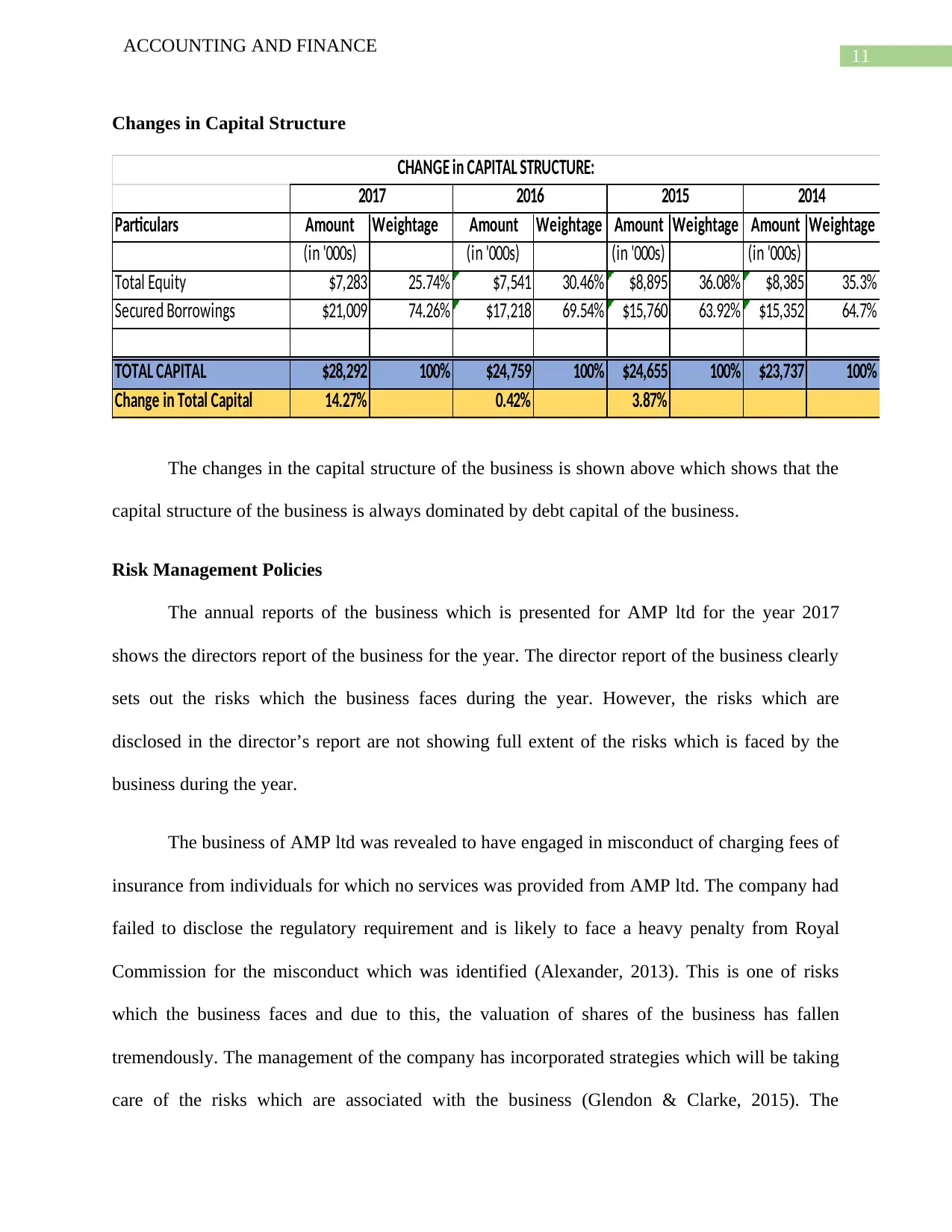
11
ACCOUNTING AND FINANCE
Changes in Capital Structure
Particulars Amount Weightage Amount Weightage Amount Weightage Amount Weightage
(in '000s) (in '000s) (in '000s) (in '000s)
Total Equity $7,283 25.74% $7,541 30.46% $8,895 36.08% $8,385 35.3%
Secured Borrowings $21,009 74.26% $17,218 69.54% $15,760 63.92% $15,352 64.7%
TOTAL CAPITAL $28,292 100% $24,759 100% $24,655 100% $23,737 100%
Change in Total Capital 14.27% 0.42% 3.87%
2015 2014
CHANGE in CAPITAL STRUCTURE:
2017 2016
The changes in the capital structure of the business is shown above which shows that the
capital structure of the business is always dominated by debt capital of the business.
Risk Management Policies
The annual reports of the business which is presented for AMP ltd for the year 2017
shows the directors report of the business for the year. The director report of the business clearly
sets out the risks which the business faces during the year. However, the risks which are
disclosed in the director’s report are not showing full extent of the risks which is faced by the
business during the year.
The business of AMP ltd was revealed to have engaged in misconduct of charging fees of
insurance from individuals for which no services was provided from AMP ltd. The company had
failed to disclose the regulatory requirement and is likely to face a heavy penalty from Royal
Commission for the misconduct which was identified (Alexander, 2013). This is one of risks
which the business faces and due to this, the valuation of shares of the business has fallen
tremendously. The management of the company has incorporated strategies which will be taking
care of the risks which are associated with the business (Glendon & Clarke, 2015). The
ACCOUNTING AND FINANCE
Changes in Capital Structure
Particulars Amount Weightage Amount Weightage Amount Weightage Amount Weightage
(in '000s) (in '000s) (in '000s) (in '000s)
Total Equity $7,283 25.74% $7,541 30.46% $8,895 36.08% $8,385 35.3%
Secured Borrowings $21,009 74.26% $17,218 69.54% $15,760 63.92% $15,352 64.7%
TOTAL CAPITAL $28,292 100% $24,759 100% $24,655 100% $23,737 100%
Change in Total Capital 14.27% 0.42% 3.87%
2015 2014
CHANGE in CAPITAL STRUCTURE:
2017 2016
The changes in the capital structure of the business is shown above which shows that the
capital structure of the business is always dominated by debt capital of the business.
Risk Management Policies
The annual reports of the business which is presented for AMP ltd for the year 2017
shows the directors report of the business for the year. The director report of the business clearly
sets out the risks which the business faces during the year. However, the risks which are
disclosed in the director’s report are not showing full extent of the risks which is faced by the
business during the year.
The business of AMP ltd was revealed to have engaged in misconduct of charging fees of
insurance from individuals for which no services was provided from AMP ltd. The company had
failed to disclose the regulatory requirement and is likely to face a heavy penalty from Royal
Commission for the misconduct which was identified (Alexander, 2013). This is one of risks
which the business faces and due to this, the valuation of shares of the business has fallen
tremendously. The management of the company has incorporated strategies which will be taking
care of the risks which are associated with the business (Glendon & Clarke, 2015). The
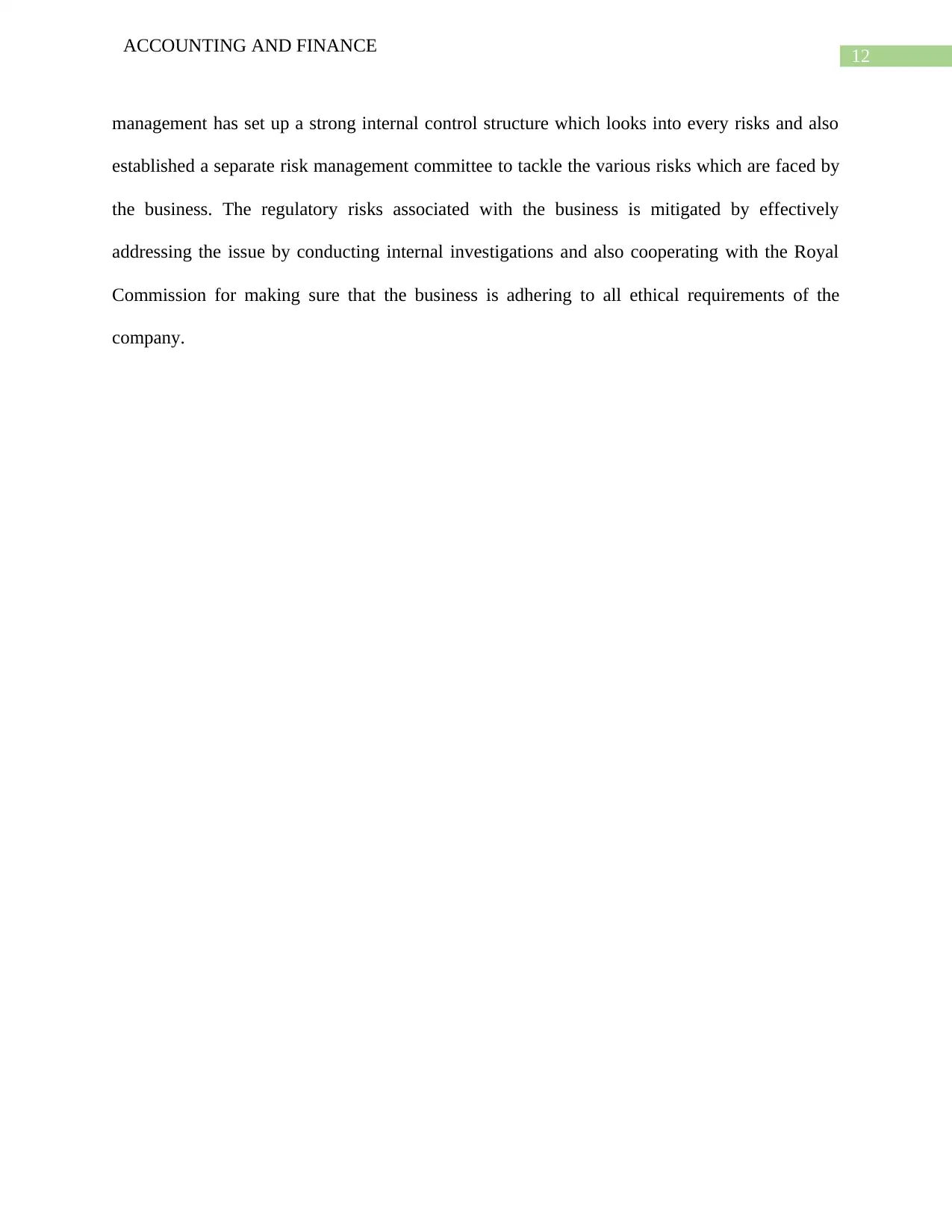
12
ACCOUNTING AND FINANCE
management has set up a strong internal control structure which looks into every risks and also
established a separate risk management committee to tackle the various risks which are faced by
the business. The regulatory risks associated with the business is mitigated by effectively
addressing the issue by conducting internal investigations and also cooperating with the Royal
Commission for making sure that the business is adhering to all ethical requirements of the
company.
ACCOUNTING AND FINANCE
management has set up a strong internal control structure which looks into every risks and also
established a separate risk management committee to tackle the various risks which are faced by
the business. The regulatory risks associated with the business is mitigated by effectively
addressing the issue by conducting internal investigations and also cooperating with the Royal
Commission for making sure that the business is adhering to all ethical requirements of the
company.
Paraphrase This Document
Need a fresh take? Get an instant paraphrase of this document with our AI Paraphraser
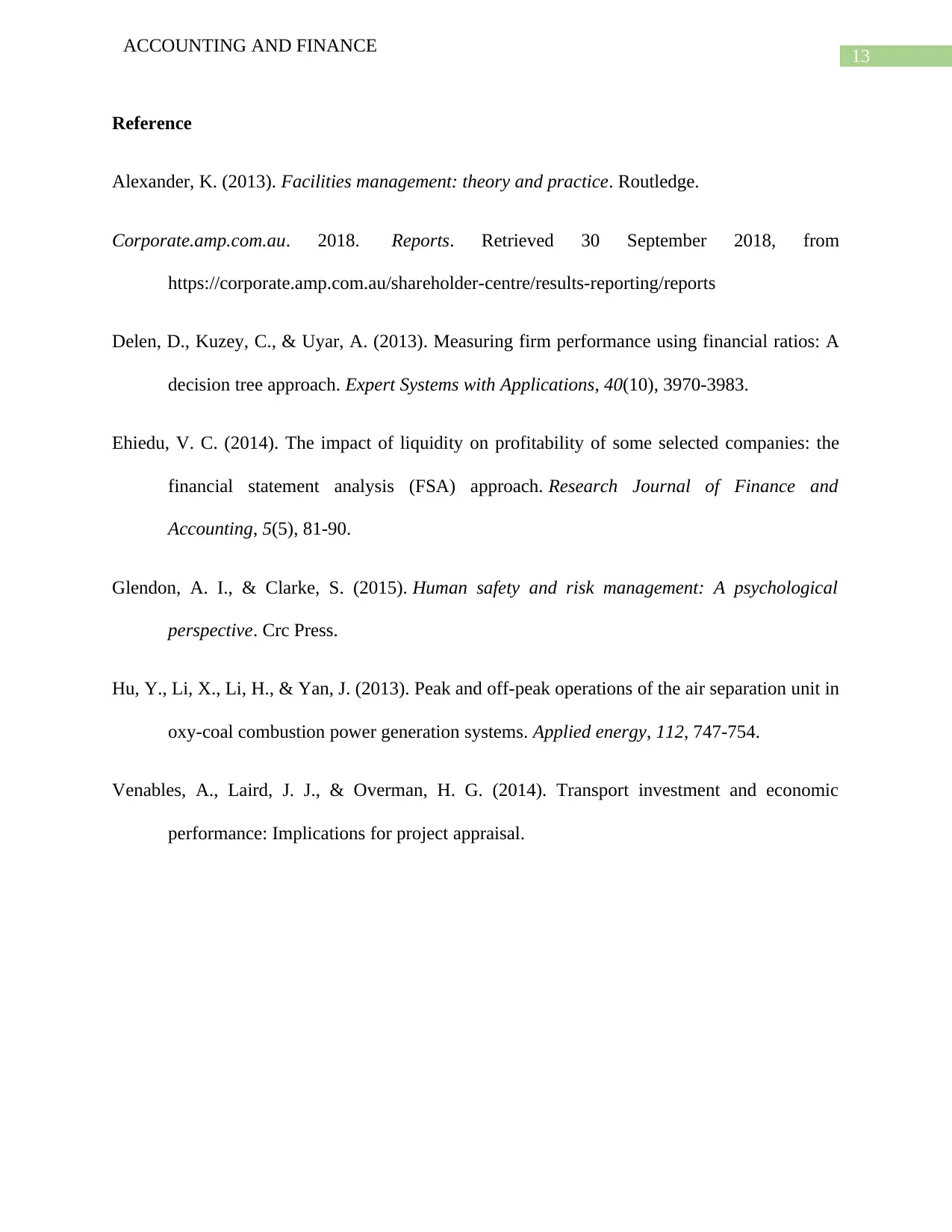
13
ACCOUNTING AND FINANCE
Reference
Alexander, K. (2013). Facilities management: theory and practice. Routledge.
Corporate.amp.com.au. 2018. Reports. Retrieved 30 September 2018, from
https://corporate.amp.com.au/shareholder-centre/results-reporting/reports
Delen, D., Kuzey, C., & Uyar, A. (2013). Measuring firm performance using financial ratios: A
decision tree approach. Expert Systems with Applications, 40(10), 3970-3983.
Ehiedu, V. C. (2014). The impact of liquidity on profitability of some selected companies: the
financial statement analysis (FSA) approach. Research Journal of Finance and
Accounting, 5(5), 81-90.
Glendon, A. I., & Clarke, S. (2015). Human safety and risk management: A psychological
perspective. Crc Press.
Hu, Y., Li, X., Li, H., & Yan, J. (2013). Peak and off-peak operations of the air separation unit in
oxy-coal combustion power generation systems. Applied energy, 112, 747-754.
Venables, A., Laird, J. J., & Overman, H. G. (2014). Transport investment and economic
performance: Implications for project appraisal.
ACCOUNTING AND FINANCE
Reference
Alexander, K. (2013). Facilities management: theory and practice. Routledge.
Corporate.amp.com.au. 2018. Reports. Retrieved 30 September 2018, from
https://corporate.amp.com.au/shareholder-centre/results-reporting/reports
Delen, D., Kuzey, C., & Uyar, A. (2013). Measuring firm performance using financial ratios: A
decision tree approach. Expert Systems with Applications, 40(10), 3970-3983.
Ehiedu, V. C. (2014). The impact of liquidity on profitability of some selected companies: the
financial statement analysis (FSA) approach. Research Journal of Finance and
Accounting, 5(5), 81-90.
Glendon, A. I., & Clarke, S. (2015). Human safety and risk management: A psychological
perspective. Crc Press.
Hu, Y., Li, X., Li, H., & Yan, J. (2013). Peak and off-peak operations of the air separation unit in
oxy-coal combustion power generation systems. Applied energy, 112, 747-754.
Venables, A., Laird, J. J., & Overman, H. G. (2014). Transport investment and economic
performance: Implications for project appraisal.
1 out of 14
Related Documents
Your All-in-One AI-Powered Toolkit for Academic Success.
+13062052269
info@desklib.com
Available 24*7 on WhatsApp / Email
![[object Object]](/_next/static/media/star-bottom.7253800d.svg)
Unlock your academic potential
© 2024 | Zucol Services PVT LTD | All rights reserved.



![[UNLOCK] Income Statement Analysis](/_next/image/?url=https%3A%2F%2Fdesklib.com%2Fmedia%2Fimages%2Fcd%2F13d7a2dc37654b80b8558c2cd598b02d.jpg&w=256&q=75)
